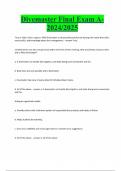Samenvatting
Summary Integrative Neuroscience
Summary of the lectures of Integrative Neuroscience. This document also containes some additional information, if I sometimes did not understand the explanation in the lectures. Integrative Neuroscience is a course given at the RUG in the second year of the study Biology. I got an 8.67 for the exam...
[Meer zien]













